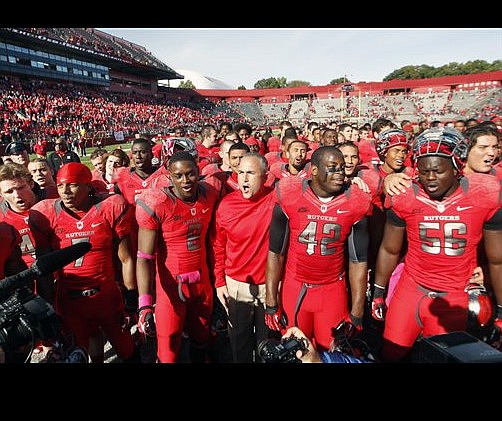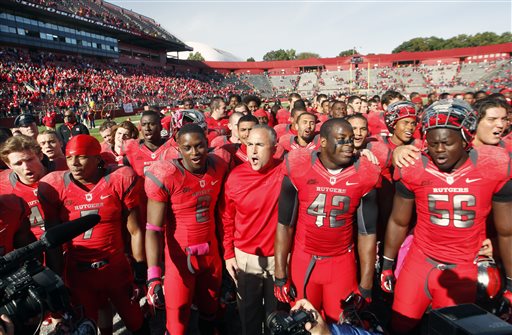The meeting was brief. A few minutes tops.
Temple athletic director Kevin Clark didn't mince words. Standing inside the football team's indoor practice facility earlier this month, Clark scanned the crowd of dozens of student-athletes -- none of them football players -- and told them the financially strapped athletic department was cutting their sport at the end of the 2013-14 academic year.
There weren't a lot of details. No lengthy question and answer session. Sitting alongside his 16 teammates on the men's gymnastics team, sophomore Evan Eigner sat in stunned silence.
"When I heard the news," Eigner said, "I kind of went numb a little bit."
Temple's announcement that it's going from 24 sports to 17 next fall, a move that will eventually save about $3-3.5 million a year, was just the latest in a growing line of colleges and universities that are reshaping overextended athletic programs by shuttering smaller sports to help make those that remain -- particularly those designed to bring in revenue -- more competitive.
To be honest, Eigner still isn't sure what happened. He understood the athletic department was in a tight spot money-wise. He knew there had been talk about changes and the threat of cuts. It was all just white noise until suddenly, it became only too real.
He heard the part where Clark said the school would honor all of the scholarships for the affected student athletes until they graduated. He heard the part where Clark said the school would do what it could to find new athletic homes for those wishing to transfer.
Eigner just didn't hear what he would consider a sensible argument for cutting a program that takes up a small fraction of the athletic department budget yet nets conference championships. He grew up wanting to compete at Temple, where his stepfather Fred Turoff has been coach since 1976. He grew up wanting to walk out of his graduation ceremony with a degree in hand and four years of college gymnastics under his belt.
Now he may get one or the other, but not both.
"I wouldn't want to go anywhere else but Temple," Eigner said. "Gymnastics is a big part of my life. Competing collegiately is a big goal of mine. For our team, gymnastics is really a part of our identities. If you take away the opportunity, you're affecting who we are as individuals."
A growing number of whom are finding themselves forced to choose between staying in school or competing elsewhere after their programs are dissolved to help other sports deal with geographically confounding -- if more lucrative -- conference alignments, increased travel budgets and coach salaries.
Rutgers did it in 2007. Maryland followed suit in 2012. It's not just the schools in power conferences either. Robert Morris, which plays in the Northeastern Conference, is trimming seven sports in 2014. Spelman College, a Division III historically black women's college in Atlanta, dropped intercollegiate athletics altogether this year in favor of a health and fitness program designed to benefit all 2,100 students. Though some schools are expanding -- Duke announced recently it is adding softball in 2018 -- the Blue Devils are a deep-pocketed exception.
While athletic departments at the Division I level aren't going anywhere, schools that opt to downsize are faced with thorny questions. The biggest is the notion that athletes in one sport are more valuable to the school -- and vice versa -- than athletes in another.
"It's a football thing and chasing the dollars," said Turoff, who has led Temple men's gymnastics to 18 Eastern Intercollegiate Gymnastics League titles. "But there's nowhere in the mission statement of the athletic department that its goal is to raise money.
"It's to give opportunity to student athletes."
Robert Morris athletic director Craig Coleman isn't quite so sure that's a fair assessment. Like Clark at Temple and Maryland athletic director Kevin Anderson, Coleman stressed the school's decision-making is designed to do a better job of providing a level playing field for the sports it does offer.
The private school located 15 minutes west of Pittsburgh is thriving. Enrollment is skyrocketing so quickly the university bought a Holiday Inn located just off campus and turned it into a dorm. It wasn't always that way. Robert Morris added six sports between 2004-06 in part to help make the transformation from commuter school into a destination. While Coleman allows it worked, it also stretched the department thin.
"For years, the emphasis was on growing enrollment and adding sports and not necessarily having funding to make those sports competitive," Coleman said. "It was about quantity and not quality."
The Colonials spent less money per student-athlete than any other program in the NEC. While there was enough money to field 23 teams, there wasn't enough in the school's $13 million athletic budget to give each sport what the school feels is necessary to become a contender.
The field hockey program, one the Colonials are cutting, went 11-8 this fall but is one of the few Division I programs in the country that doesn't practice or play on an artificial surface. The substandard facilities makes scheduling difficult.
"It's like having the ice hockey team practicing on slush," Coleman said.
With no plans or money to build a state-of-the-art field and a travel budget stretched to the limit, the school felt it would be easier cut field hockey entirely. Coleman said several field hockey players are in the process of transferring, one of the reasons Robert Morris announced the decision early.
Coleman pledges to invest the estimated $1-1.3 million the school will save when the students for the six eliminated sports are off the books to beefing up the recruiting and travel budgets for the remaining sports, including a men's basketball program that upset mighty Kentucky in the NIT last spring. The victory, complete with a court-storming at the final buzzer, gave the school the kind of splashy public relations boost Olympic sports can't provide.
It's that way across the board in college athletics, where football and men's basketball are typically the engines that drive the budget. Yet even with television money pouring into power conferences, the price of keeping up with the big boys is steep.
In 2012, the cost of operating a Division I football program rose 10.8 percent according to the NCAA. At the same time, revenue rose only 4.6 percent. The declining profit margin -- if the program is profitable at all -- combined with the shifting conference affiliation landscape is putting some schools in a bind. But with belt-tightening on college campuses becoming more widespread even as tuition levels jump at an exponential rate, athletic departments are no longer immune.
Rutgers was ahead of the curve when it dropped six sports in 2007, most to help offset a university-wide $80.7 million shortfall. The cuts had little long-term effect on the health of the athletic department. Rutgers athletics spent $28.7 million more than it made in 2011, with the school taking money from its general fund and student fees to cover the rest.
Meanwhile, the results on the field have been middling at best. The Scarlet Knights have gone a respectable 53-36 with six bowl appearances in football since 2007 and attendance at High Point Solutions Stadium has averaged more than 45,000, better than it was 15 years ago but still short of the new seating capacity of 52,454 that came with a $102 million expansion completed in 2009.
The men's basketball team continues to struggle and is dealing with the ugly fallout from former coach Mike Rice's bumpy tenure. The women's basketball team, a national power at times under C. Vivian Stringer, has seen attendance drop by more than half since 2007-08.
Things are even more dire at Temple. The football program, which moved from the Mid-American Conference back to the Big East (the remnants of which are now called the American Athletic Conference), averaged just 22,473 fans this year at cavernous Lincoln Financial Field, an NFL stadium that houses the Philadelphia Eagles. And with the AAC no longer guaranteed a spot in one of college football's marquee bowls next season (and the $17 million payout that comes with it) lean times could get even leaner.
A major factor is the increased cost of travel. The AAC now spreads from Connecticut to Texas. It's not just the football team making those trips. Most of the 15 other sports that will stick around need to play in Houston, Memphis and Florida too.
Clark maintains even with mediocre attendance and even more miserable results, football prevents the athletic department from being subsidized entirely by the university. Deputy athletic director Pat Craft said the athletic department was "limping along" on a $44 million budget spread across 24 sports. Going down to 17 will leave Temple in line with most other AAC schools.
Not that it provides much solace to Eigner. Sure he could explore a transfer, but when Temple is gone there will be only 16 Division I men's gymnastics programs remaining. Finding a landing spot will be difficult. The Owls begin their final season of competition on Jan. 17, 2014.
"Obviously an opportunity has been taken away from us," he said. "We're trying not to think about it too much if that makes sense. We can only control what we can control. This sport is really who we are."
Or, as of July 1, 2014, who they were.

